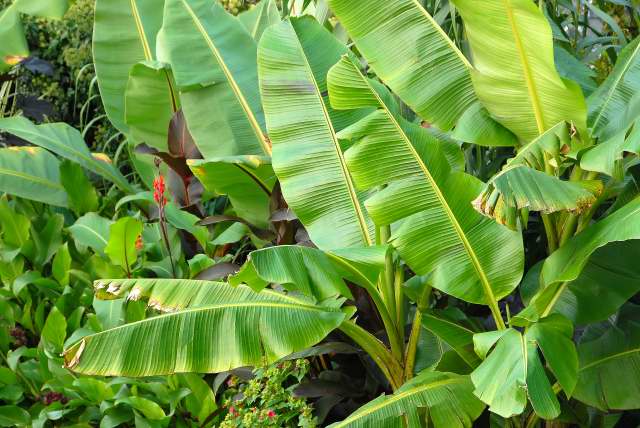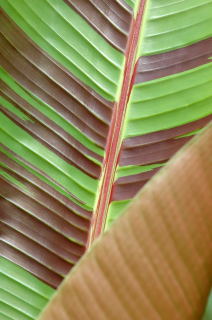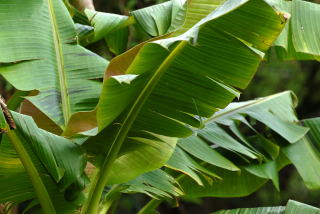Cold Hardy bananas

Banana plants
Cold hardy bananas must not be confused with frost hardy. No bananas will be able to tolerate a proper freeze and survive in tact. There are a handful of bananas described as root hardy, but as the name implies, it is the only roots that will survive. The stems will be obliterated and your once proud banana plant will be reduced to a few pathetic shoots emerging from the roots. However a relatively simple techique can be used to successfully over winter your bananas stem and all.
There are two cold hardy bananas of proven pedigree.
Musa Basjoo
- The Japanese hardy banana, the original and some would say the best. A plain green variety.Musa Sikkimensis
 - originally marketed as the much easier to pronounce
Musa Hookerii. A banana from altitude in the Himalayas, sporting jungle camouflage markings. No doubt the reason why it went
un-noticed for all these years.
- originally marketed as the much easier to pronounce
Musa Hookerii. A banana from altitude in the Himalayas, sporting jungle camouflage markings. No doubt the reason why it went
un-noticed for all these years.
Both these bananas can be protected over winter without the bother of having to dig anything up. This allows the bananas, over a few seasons, to gain a bit of stature in your garden. Having tall plants with tropical foliage helps to add a sense of permanence to your garden. This makes them very handy if greenhouse space is at a premium or non existent.
Getting your hands on these two cold hardy bananas is relatively easy. Both varieties are widely available from specialist nurseries. Musa Basjoo seems to turn up all over the place these days. Unfortunately Musa Basjoo is unavailable from seed. It is not terribly expensive to buy small plants though.
Musa Sikkimensis on the other hand can be propagated from seed.
So whether you have propagated your cold hardy banana from seed or bought a growing plant you need to put it somewhere in the garden. Some thought needs to go into the location of the plant. These plants will be planted in a permanent position. Generally It is best to plant any permanent members of your garden in groups. A group of established plants close together will be better able to share the available resources in the soil. Once the frost has wiped out all tender plants your garden looks marginally better if the remaining uprights are grouped together.

Wind damaged Musa Sikkimensis
Cold hardy bananas appreciate sun, water and a rich soil to grow well. It does not matter if the banana plants are planted in a position that is in shade during winter. The plants will be covered up. They do not like wind, or rather you will not like the way they look in a windy location.
You are unlikely to need to plant more than one specimen in your garden. Unlike ensete ventricosum the abyssinian banana, Musa species produce suckers (baby plants) and relatively soon create a colony, radiating out from the original plant. Once you have chosen a location for your banana plant, you need to prepare the soil well. Dig plenty of home made compost and composted manure into an area considerably bigger than your new plant's pot. Pop the plant it the soil and water well.
Bananas respond well to water, particulary in hot weather. At the same time they seem to cope without much additonal water once established. This feature allows you more stress free holidays. Half the fun though with bananas, is seeing just how fast and big you can grow them.
As summer turns to autumn you need to start thinking about protecting cold hardy bananas over winter.

